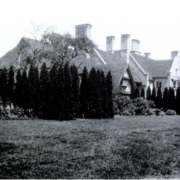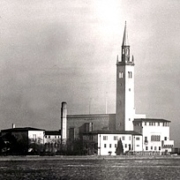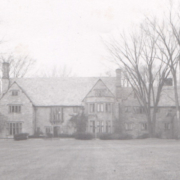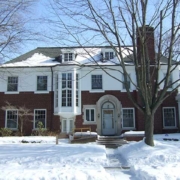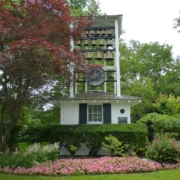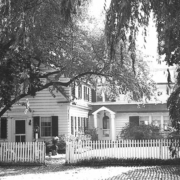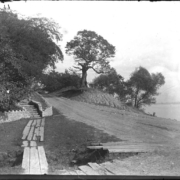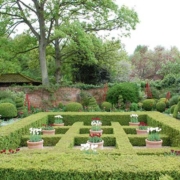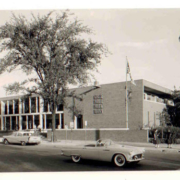Historical Architecture of Grosse Pointe – Gardeners World – Landscape Architects: Jens Jensen and Fletcher Steele
Last week we covered the extraordinary work of nationally renowned landscape architect Ellen Biddle Shipman, and her work here in Grosse Pointe.
This week we continue our review of the prominent landscape architects who have worked in the community by profiling two internationally acclaimed designers – Jens Jensen and Fletcher Steele.
While Ellen Biddle Shipman created over 60 gardens in Grosse Pointe – more than any other community in the United States – Jens Jensen and Fletcher Steele designed one garden each respectively. Commissioned by two leading business figures in Detroit, their contribution was to create a beautiful garden that reflected the design of the exquisite home(s).
Jens Jensen: The Edsel and Eleanor Ford House – 1929
Having designed the garden for Henry Ford’s estate in Dearborn, Edsel had gotten to know Jensen and admired his work immensely.
Edsel Ford hired Jensen to work on four residential projects. The first, in 1922, was Edsel and Eleanor’s summer estate ‘Skylands’ in Bay Harbor, which was followed by another of their Michigan residences, ‘Haven Hill’. In 1927 Edsel commissioned Jensen to design the gardens at his new estate in Grosse Pointe Shores. It was Jensen’s largest private commission, and arguably his most ambitious and most challenging project.

View towards the house – courtesy of www.daads.org
Having created a master plan, Jensen’s design at Gaukler Point needed to factor in the mass of water, and the shoreline, whilst accommodating a great meadow – stretching from the house toward the sunset. The great meadow would form the centerpiece to his design.
Based on research from Wikipedia, we know Jensen ‘employed his traditional ‘long view’ giving visitors a glimpse of the residence down the long meadow after passing the entry gates, then only brief partial views along the long drive, and only at the end revealing the entire house and another view back up the long meadow’.
The total area of the Ford Estate (at the time) was 65-acres. Aside from creating the great meadow, Jensen also created a bird-sanctuary (increasing the shoreline to more than 3,000 feet), a lagoon, and a naturalistic swimming pool surrounded by plants from the Michigan woods – source: fordhouse.org The following photo’s are by Carol Betsch (1998) and are courtesy of the Library of American Landscape History (http://lalh.org/)
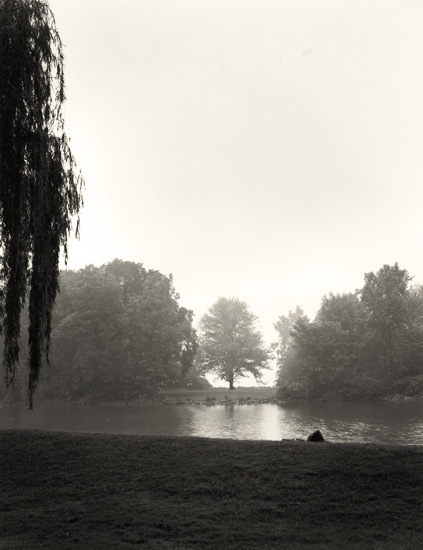

View east to lake St. Clair – Courtesy of lalh.org

The rose garden – Courtesy of lalh.org
Jens Jensen was born in Denmark, 1860, to a wealthy farming family. Having gained an appreciation for the natural environment he attended the Tune Agricultural School (outside Copenhagen). After graduating he was required to undertake military service for three years. In 1884, after getting engaged, Jensen and his fiancée immigrated to the United States.

Jens Jensen – Courtesy of www.fordhouse.org
Having worked in Florida, Jensen headed north, where he would eventually spend many years working for the park system in Chicago. In 1920 he started his own landscape architecture business, specializing in designing private estates and municipal parks throughout the US. Many of designs would consist of open spaces and pathways, making the most of native species, and utilizing his talents in creating distinctive areas of shade and light.
Fletcher Steele: The Standish Backus Estate – 1934
Standish Backus hired Fletcher Steele to design the garden for one of Grosse Pointe’s grandest homes. Situated on a 12-acre estate Mr. Backus, a lawyer, engineer, general Counsel for General Motors (in 1911) and President of the Burroughs Adding Machine Company (in 1920) wanted a formal garden to emphasize the design of his distinguished residence located at 725 Lakeshore (demolished in 1966).

View towards the house – Courtesy of ‘Fletcher Steele, Landscape Architect’ (By Robin S. Karson) – Google books.
It is believed Fletcher Steele was probably introduced to Mr. Backus through Ralph Cram – Mr. Backus’s architect and friend. Backus commissioned Steele to set about creating a design for the garden to work in harmony with the design of the house. Based on research from Fletcher Steele, Landscape Architect, by Robin S. Karson, we know Steele worked closely with Cram on the landscape design, which grew substantially to a 12-acre project (after Backus purchased an additional 7 acres), from the 5-acre project that was planned initially.
Research by Karson states that Standish Backus and his wife, Dorothy, a keen gardener, were heavily involved with the design of the garden, focusing heavily on architectural elements as opposed to the plants. The formal garden Steele ultimately created included sweeping lawns, a large pond, and numerous Baroque architectural features.
It is believed that Steele was very creative in the use of large box bushes, and included rows of clipped European beech and linden trees. He approached the design of the garden by creating sections. Each section used architectural elements and plants to define the area, with the sections fitting together ‘like an ingenious jigsaw puzzle’, as depicted by the photo’s below – courtesy of ‘Fletcher Steele, Landscape Architect’ (By Robin S. Karson) – Google books.




Robin S. Karson’s research suggests that Steele ‘was at his artistic best with opinionated clients whose non-negotiable demands stimulated his imagination’.
Fletcher Steele was born in Rochester, New York, 1885. In 1907 he attended Harvard University to study landscape architecture. Having completed his studies, and an apprenticeship with prominent landscape designer Warren H. Manning, Steele, in 1913, went on a four-month tour of Europe to study European designs. When he returned to America he opened his own practice.

Fletcher Steele – Courtesy of tclf.org
In the 1920’s the Art Deco movement heavily influenced Steele, and his modernistic designs. Steele is credited with designing over 700 gardens in the United States from 1915 until his death in 1971.
*Photos courtesy of the Higbie Maxon Agney archives unless stated.
Written by Katie Doelle
Copyright © 2016 Katie Doelle

